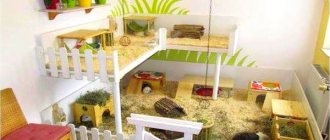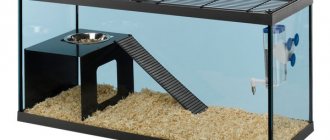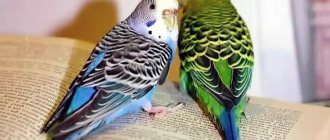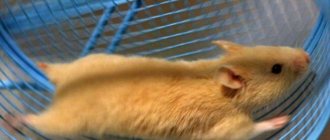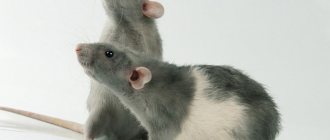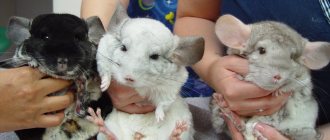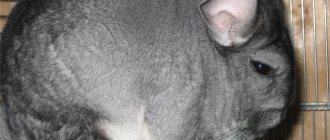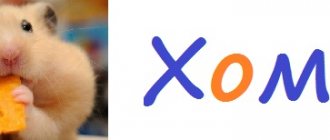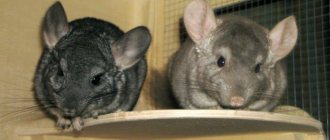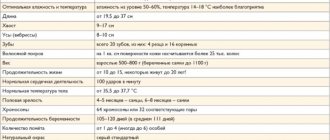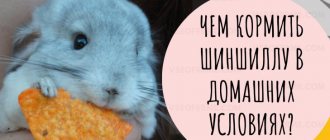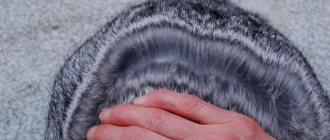- home
- Chinchilla
- Nutrition
03/25/2019 Good hay is an important part of a chinchilla's daily diet. It promotes the growth of young animals and proper development. It contains minerals, phosphorus and calcium, which support the health of not only chinchillas, but also other pets.
Feeding a rodent: hay for chinchillas
Hay is the most important component of a chinchilla's diet. Most experts believe that there should always be hay in the cage of these rodents so that the animals can eat as much of it as they want. It is rich in fiber, which is so necessary for animals.
Properly harvested high-quality hay smells pleasant, without sticks, debris and other impurities. Wet and moldy food is not suitable for animals.
In specialized stores you can find various types of hay (from legumes, meadow, forest, etc.). You can prepare it yourself.
The best hay is made from leguminous grasses (clover, alfalfa, vetch). It contains vitamins and minerals (phosphorus and calcium) necessary for animals. In addition, it is very nutritious and contains a sufficient amount of digestible protein. Leguminous grasses need to be mowed in the budding phase or at the beginning of flowering.
Clover
Vika
Alfalfa
The best time for mowing cereals is the heading phase. Cereal hay (meadow fescue, timothy, cocksfoot, meadow grass) is somewhat inferior to legume hay (it contains less protein and minerals).
Forb hay is very nutritious if it contains legumes and cereals, as well as bird buckwheat, salsify, etc. Before flowering, herbs are especially rich in vitamins and nutrients. Therefore, the hay should consist of forbs, mowed before the first flowering of the grass. Late-cut grasses have low nutritional value.
Ferns, rush grass, datura, black nightshade, spurge, horsetail, white hellebore, henbane, cornflower, crow's eye and other poisonous plants should absolutely not be included in chinchilla hay.
How to prepare it yourself
You don't have to go to the pet store to buy hay for your chinchilla. It will be much more economical to make the blank yourself. The best time to collect is late spring/early summer. You should try to mow the grass before flowering begins. It is during this period that plants contain the greatest amount of nutrients. You also need to make sure that the grass grows in an environmentally friendly area - away from highways and industrial facilities.
The algorithm for preparing hay for a chinchilla is as follows:
- Selecting a suitable lawn and mowing the grass.
- Drying the cut plants in swaths until their humidity drops to 50-55%. It is worth considering that the leaves dry out first. Old plants also dry out faster than young ones. The average drying time for cereals is 5.5-6 hours, for legumes – 3 hours.
- Drying of grass in windrows and stacks. You can also dry the hay on hangers, spreading it out in a thin layer.
When the moisture content of the mass decreases to 18-20%, the hay is transferred to the barn, having previously laid straw under it and cleared the storage area of debris.
When harvesting hay on a small scale, it is necessary to arrange sunny weather. In such a case, the beveled mass should be spread out in a thin layer on several baking sheets or in large cardboard boxes, and left to dry in the sun for 7-8 hours.
Before drying, it is necessary to clean the grass from dirt, insects and moldy or rotten plants.
The output should be fragrant green hay with a slight yellowish or marshy tint (depending on the type of plant). The finished product should not contain impurities in the form of dust or sand.
Some chinchilla owners prefer to dry the hay directly in the oven to speed up the process. However, this is a fundamentally wrong approach. This way, most of the beneficial substances will quickly disappear from the product.
In addition, when dried in the sun, the hay is enriched with vitamin D, which is very beneficial for the chinchillas’ body. It strengthens the immune system, improves the condition of the coat, strengthens the nervous, cardiovascular and respiratory systems, and keeps the pet’s bones and teeth in good condition.
Ready-made feed
Today, in any specialized store you can purchase ready-made food for furry pets. They come in two types: regular and granular. Granulated food is more economical, but chinchillas often prefer whole food, in which all components are contained in their natural form. Animals often choose individual “goodies” from them, but the rest has to be thrown away. When feeding granulate, the diet turns out to be more balanced, since the animals, willy-nilly, have to eat everything. The granules, as a rule, contain all the vitamins and minerals the animal needs, including calcium. 1-2 tablespoons of this food per day will be enough for the animal.
From time to time, you can feed rodents with ready-made rabbit food. In principle, feeding chinchillas is not much different from feeding rabbits. In the summer, the same green grass, vegetables with tops, plant seeds, fruits. In the cold season - hay, tree branches (birch, apple, linden, pear, hazelnut, willow, willow), dried fruits (apples, raisins, dried apricots, nuts). Dried fruits are offered to the animal, pitted and finely chopped. The fruits of barberry, rose hips and hawthorn are very useful. They are given one berry 1-2 times a week.
Green food, vegetables and fruits
The warm season makes it possible to significantly expand the chinchilla menu. In spring, the first greens are given very carefully, starting with portions of 1-2 well-dried dandelion leaves per day. To prevent the animal from having a bloated tummy, the stems of legumes and clover are always used dry or withered. You should not feed your chinchilla only green food, forgetting about hay. This may lead to gastrointestinal disorders.
Here are the characteristics of some plants that will be useful to include in a chinchilla’s diet:
- salad is a storehouse of vitamins and mineral salts. You can give your pet 1-2 leaves per day;
- spinach – rich in easily digestible iron, contains sodium and lime. Spinach is believed to increase fertility in rodents. You can give 3-4 leaves per day;
- chicory - contains a lot of phosphorus, which growing organisms especially need. The cleansing plant acts on the stomach, regulates liver function, and increases appetite;
- Strawberry leaves – have a diuretic effect, help with diarrhea. Can be given for indigestion;
- celery – contains vitamins A, B, C. Very useful for nursing females, 2 leaves 2 times a week;
- wormwood – increases appetite, strengthens the nervous system. The pet is given several branches a week.
In addition, the animals happily eat plantain leaves, yarrow, burdock, young nettles, horse sorrel, and dandelion.
From vegetables and fruits, you can give carrots, pumpkin, squash, apples, pears, sweet peppers, bananas, grapes, figs, zucchini, potatoes, tomatoes, peaches, apricots, melons, watermelons, etc. It is not recommended to give fresh cabbage leaves to chinchillas.
Grain food in a chinchilla's diet
The following grain foods can be given to chinchillas:
- oats – contains proteins, fats, vitamins B1, B2, B6, K, carotene. For indigestion, the mucous substances contained in the broth and oatmeal are useful. Typically, oats are used as the base for a grain mixture;
- barley is a valuable grain product; contains vitamins A, D, E, PP, B vitamins, as well as calcium, zinc, potassium, phosphorus, iron, copper, manganese, iodine, etc. 6% consists of fiber necessary for animals. It is given to adults and preferably in ground form;
- Buckwheat is a valuable dietary product. Rich in amino acids, vitamins (B1, B2, B6, PP, P) and microelements. As a complex carbohydrate, buckwheat gives you a feeling of fullness for a long time;
- corn is rich in protein, but it is worse in composition than oat protein. It must be given carefully; in excessive quantities it can cause bloating;
- wheat – contains enough proteins and carbohydrates and little fat. Animals can also be offered wheat bran mixed with grain;
- millet - red varieties containing large amounts of carotene are especially useful. However, chinchillas don't like it too much.
You should not constantly give one type of grain feed; it is better to feed chinchillas a grain mixture (various types of grains, legumes, seeds).
You can offer your pets porridge (oatmeal, corn, rice, millet). Young fish grow well on porridge (they digest it better than whole grain).
Sprouted grain is also very useful for rodents, especially during the breeding season. Usually barley, oats, and wheat are sprouted.
Animals eat the seeds with great pleasure. They contain essential fatty acids, which have a positive effect on the skin and fur of animals. However, due to the high fat content, it is not recommended to feed them too much. The share of sunflower seeds should not exceed 20% of the total grain feed. They are only given raw.
Legumes. Beans, lentils, peas, and soy contain more protein than all grain products. They need to be included in the chinchillas’ diet, but not in their pure form, but as part of a grain mixture. The share of legumes should be 10-15%. They are given in ground form.
Nuts are a very nutritious food. Chinchillas love them. But you can give them very little and no more than twice a week, otherwise digestive upset will not be avoided. Of course, the nuts must be raw.
How to store hay
When storing hay in a barn, it is necessary to ensure that it is well ventilated, and also that access to it is limited for rodents and other animals. At home, food storage is carried out according to the following rules:
- The hay is distributed in paper bags or linen bags, but it should not be compacted too tightly - it is advisable that there are small gaps between the blades of grass.
- It is allowed to spread the hay in cardboard boxes. To make the hay “breathe”, it is better to make several small holes in the lids.
- Bags or boxes of hay should not be stored in a damp place or in contact with cold surfaces.
- The workpieces should not be exposed to direct sunlight.
The contents of the packages should be inspected periodically. If mold or insects appear, the hay will have to be thrown away.
Treats for chinchillas
Now about what can be considered a delicacy for these animals. This is a necessary thing - after all, chinchillas are not exactly trainable, but they are quite capable of recognizing the owner and going into his hands. This means we need an incentive tool.
Fresh vegetables and fruits are a delicacy, and they should not replace the main food. The intestines of chinchillas are designed in such a way that succulent food in large quantities is contraindicated for them. The main thing is not to feed your pet treats. A piece of fresh apple or pumpkin, a slice of tangerine, a couple of grapes a week - this is enough to pamper your ward. Once a week you can give 1-2 raisins and a special supplement with vitamins.
The animals love pumpkin seeds, sunflower seeds, almonds, peanuts, and walnuts. Pumpkin seeds are used not only as a treat, but also as a preventive measure against worms. Pine nuts contain a lot of fat, so giving them is not recommended. You can offer your pet dry tea leaves or rose petals.
Chinchillas have a sweet tooth and love treats very much and do not know when to stop eating them. When given treats in an irregular manner, animals may refuse the main food. And eating only “delicacies” will lead to metabolic disorders, diabetes and obesity.
You can diversify the treat for the animal each time: on the first day, give a nut, on the second day - dried apricots, hawthorn fruit or chokeberry, on the third - a piece of apple or melon.
After feeding any new type of treat, you need to monitor the reaction of your pet’s body. If the animal feels well and does not suffer from diarrhea or constipation, then this food is not contraindicated for it. It happens that after eating fresh vegetables and fruits, a rodent experiences indigestion. This means you need to give up succulent food.
Roasted seeds and nuts, citruses, cabbage and potatoes, meat, eggs, mushrooms, chips and confectionery cannot serve as treats! Firstly, all this can cause allergies (including hair loss). Secondly, it can lead to intestinal problems. Thirdly, it contributes to the animal’s obesity, which can be very dangerous for it.
Water
The water in a chinchilla's drinking bowl should always be fresh without any signs of flowering. It is better to give spring water, but not boiled, since it no longer contains those beneficial microelements that the body needs. Many breeders and hobbyists use bottled water from companies such as Shishkin Les, Nestlé and others. And, of course, the water should be still.
DIY sennik
Hay can be placed in a cage in a bale, but this is not aesthetically pleasing and is dangerous, since the pigs will scatter the grass and stain it. It is more practical to place the hay in a special feeder, which will not allow the animals to scatter the contents. Rodent cages are usually equipped with a container for hay. Ready-made hay can be easily found in pet stores.
Many breeders prefer to make hay barns on their own, especially since there is a lot of scope for imagination here.
You can fill any container, box, soft toy, or even a sock with hay. Don't immediately throw away egg trays and toilet paper tubes. By filling them with hay and offering them to your pet, you can make the rodent happy and keep him occupied for several hours.
A simple haybox made from plastic containers
To make a feeder, you will need a disposable plastic container or any plastic container you have at hand, and paper clips (2 or more). The container is filled with hay and attached to the bars of the cage using clothespins. The convenient sennik is ready!
All that remains is to regularly fill it with food. If piglets show interest in paper clips, it is better to hang the clothespins higher so that the pigs do not get hurt.
How to sew a hay bag
Procedure:
- Two identical pieces of fabric (20x30 cm) are folded with the right sides facing each other.
- Next, you need to draw two round windows in the center at a certain distance from each other.
- Windows are cut out on one of the flaps, and the edges of the windows are finished with stitching.
- The product is sewn on three sides, the top remains unsewn.
- The edges of the top must be folded and stitched, after which the product is turned inside out (it turns out to be a bag).
- Then you need to sew 4 ties, 2 on each side of each edge (you get a handbag with handles).
- The bag is stuffed with hay and hung in a cage.
Sennik out of the box
You can build a feeder from a shoebox or small household appliances; it is important that it fits the size of the cage. A lid and one side wall are not needed. The side can be cut off, leaving 5 mm from each edge. Holes are made on two narrow side walls (4 on each side). The sennik is attached to the bars of the cage using fishing line or wire, which is threaded through these holes. The container is filled with hay and the hay barn is ready.
Wooden canopy
For production you will need:
- boards or furniture board;
- drill with grinding attachment;
- jigsaw;
- metal grill;
- hammer;
- furniture dowels (6 mm).
Progress:
- The boards are sawn into pieces: 2 sides 10x13cm; bottom 10X14cm; back wall 18X11 cm.
- Recesses for the grate are cut in the side walls (the width coincides with the width of the found grate).
- The upper part of the backdrop can be cut in a semicircle (optional).
- Next, the holes are marked at the joints, after which the holes are drilled with a five-millimeter drill.
- The dowels are driven into the holes in the sides with a hammer, and the back and side walls are connected.
- Then the dowels are inserted into the lower part, and the structure is assembled.
- Next, the product must be sanded and the corners smoothed.
- The grille is inserted into the grooves.
- Holes are drilled in the back for attaching to the cage, the hay box is filled with hay and hung.
Daily diet
A chinchilla's diet should consist of:
- 20-25 g of ready-made feed or from the same amount of concentrated feed (grain feed, legumes, oilseeds, bran, cake);
- 20-30 g of hay;
- 4-6 g of green food;
- 4-6 g of additional food (tree branches);
- 2-4 g treats;
- 10-25 g of water.
Chinchillas love precision, so they should be fed at the same time every day (the maximum error can be 1-2 hours).
What should you not feed chinchillas?
Rodents should not be given:
- food from the human table with salt, spices, sugar, animal products, fats, etc.;
- pastries, bread;
- fried nuts, grains, seeds;
- rye grain;
- spoiled products.
And finally, we note that for the animal’s well-being, a stable diet is important. There is no need to change the food that your pet is used to very often. It is better to transition your pet to new food gradually, over 1-2 weeks. Don't forget, the chinchilla is a delicate animal. And above all, this concerns feeding. The stomach of a furry pet is very sensitive to dietary disturbances. And mistakes in feeding can lead to serious health problems for your chinchilla.
- Feeders for chinchillas
- Malocclusion in...
- Gerbils in…
- Arrangement…
- What to feed...
- Feeding…
Which hay is best for guinea pigs?
Many owners have questions, because hay is not the only food for guinea pigs that contains fiber. Not the only one, but the richest and lowest in calories. However, hay also varies; some types of grass contain large amounts of vegetable protein, natural sugar and calcium.
Since guinea pigs chew hay almost during the entire waking period, overeating and obesity are an obvious problem if plant foods are not selected correctly.
Note! A diet high in protein and calories is only suitable for pregnant, lactating and very young individuals.
You need to understand that the guinea pig’s body is physically unable to absorb a lot of protein and calcium, as a result of which, if fed improperly, sand and stones form in the animal’s bladder.
